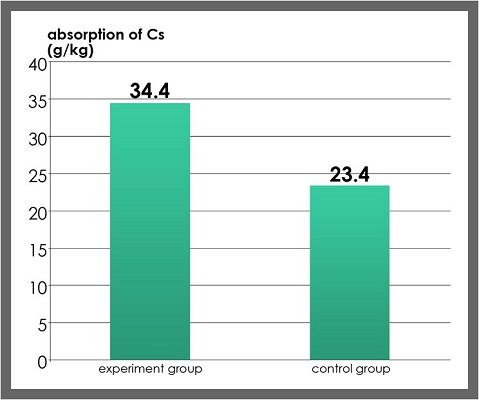Difference between revisions of "Part:BBa K629005"
(→Detailed Paramers in Result Report) |
|||
| (4 intermediate revisions by the same user not shown) | |||
| Line 2: | Line 2: | ||
<partinfo>BBa_K629005 short</partinfo> | <partinfo>BBa_K629005 short</partinfo> | ||
| − | |||
| − | |||
| − | |||
| − | + | == Introduction and Background == | |
| + | Protein TrkD (belongs to Kup system) is responsible for the low-affinity transport of potassium into the cell, but with high affinity to transport cesium. In contrast to Trk or Kdp, the Kup system does not strongly distinguish between the alkali cations K+, Rb+, or even Cs+. When both of Cs+ and K+ exist, the uptake of Cs+ has inhibition of that of K+. And among several proteins in Kup system, TrkD has the best effect of uptake of Cs+. Accordingly, after E. Coli approached Cs+, the expression of TrkD will help our E. Coli to absorb Cs-137. | ||
| − | |||
| − | |||
| − | + | == Methods to quantify the efficiency == | |
| − | + | The research about this protein are relatively few and old. It's difficult to contact with original authors to get the details in the experiments. As a result, we need to verify the value of TrkD in our project. | |
| + | Then, we first construct gene trkD on plasmid pET-32a to test the useful expression of TrkD. After the western-blot test, we construct it on pSB1C3 with promoter T7 and operator lac (see the detail in BBa_K629013), which can be induced by IPTG. | ||
| − | + | The test of function of TrkD is not easy, so we sent the sample to the test center in Guangzhou to help us. | |
| − | |||
| − | |||
| − | + | == Results == | |
| − | + | The results shown below: | |
| − | + | [[Image:Cesium_absorption.jpg]] | |
| − | |||
| − | |||
| − | + | == Reference == | |
| + | |||
| + | D. Bossemeyer et al., Journal of Bacteriology. 171, 2219 (1989). | ||
| + | |||
| + | |||
Latest revision as of 05:02, 5 November 2011
trkD, a functional Kup (formerly TrkD) system took up Cs+ with a moderate rate and affinity
Introduction and Background
Protein TrkD (belongs to Kup system) is responsible for the low-affinity transport of potassium into the cell, but with high affinity to transport cesium. In contrast to Trk or Kdp, the Kup system does not strongly distinguish between the alkali cations K+, Rb+, or even Cs+. When both of Cs+ and K+ exist, the uptake of Cs+ has inhibition of that of K+. And among several proteins in Kup system, TrkD has the best effect of uptake of Cs+. Accordingly, after E. Coli approached Cs+, the expression of TrkD will help our E. Coli to absorb Cs-137.
Methods to quantify the efficiency
The research about this protein are relatively few and old. It's difficult to contact with original authors to get the details in the experiments. As a result, we need to verify the value of TrkD in our project.
Then, we first construct gene trkD on plasmid pET-32a to test the useful expression of TrkD. After the western-blot test, we construct it on pSB1C3 with promoter T7 and operator lac (see the detail in BBa_K629013), which can be induced by IPTG.
The test of function of TrkD is not easy, so we sent the sample to the test center in Guangzhou to help us.
Results
The results shown below:
Reference
D. Bossemeyer et al., Journal of Bacteriology. 171, 2219 (1989).
Sequence and Features
- 10COMPATIBLE WITH RFC[10]
- 12COMPATIBLE WITH RFC[12]
- 21INCOMPATIBLE WITH RFC[21]Illegal BamHI site found at 245
- 23COMPATIBLE WITH RFC[23]
- 25COMPATIBLE WITH RFC[25]
- 1000INCOMPATIBLE WITH RFC[1000]Illegal SapI.rc site found at 1320

